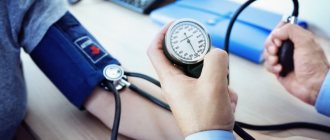Normal blood glucose levels range from 2.3 to 6.0 mmol/l on an empty stomach. After a meal, the value should not exceed 7.8 mmol/l. If the norm is violated, this indicates the development of diabetes. Moreover, even with a confirmed diagnosis, it is quite possible to stabilize the indicator. To do this, you need to adjust your diet, engage in regular physical activity and give up bad habits.
Blood sugar levels: table by age
When people talk about normal sugar levels, they mean a certain concentration of glucose in a person’s blood. The indicator is measured in millimoles per liter (abbreviated mmol/l) and is determined during a blood test, which today can be done both in the hospital and at home.
The norm is presented as a range from 3.3 to 5.5 mmol/L, and not a specific value. It depends on various factors:
- age;
- state of the body;
- eating, drinking;
- lifestyle features.
However, there is no direct connection between gender and sugar levels. In this regard, the body of a man and a woman works approximately the same. Therefore, the table shows general data (assuming blood is taken from a finger on an empty stomach).
| age | glucose level, mmol/l |
| under 14 years old | from 2.3 to 3.9 |
| 14-19 years old | from 2.5 to 4.0 |
| 20-49 years old | from 3.0 to 5.5 |
| 50 years and older | from 3.5 to 6.5 |
Small deviations (within a few tenths) are allowed. They are associated with lifestyle habits, food intake, smoking, alcohol and other habits.
Attention!
After eating, your sugar levels rise, which is completely normal. But even in this case, it should not exceed 7.8 mmol/l.
Causes of diabetes
There can be quite a few causes of diabetes, so let’s highlight the most significant:
- heredity;
- age (the older the person, the greater the likelihood of getting sick);
- obesity;
- nervous tension;
- diseases that destroy beta cells of the pancreas that produce insulin: pancreatic cancer, pancreatitis, etc.;
- viral infections: hepatitis, chickenpox, rubella, influenza, etc.
In addition, diabetes mellitus can develop against the background of:
- hyperfunction of the adrenal glands (hypercortisolism);
- tumors of the gastrointestinal tract;
- increased levels of hormones that block insulin;
- liver cirrhosis;
- hyperthyroidism;
- poor digestibility of carbohydrates;
- short-term increase in blood sugar levels.
According to the severity of the disease:
Diabetes mellitus 1 degree (mild form). Characterized by a low level of glycemia (blood sugar) - no more than 8 mmol/l (on an empty stomach). The level of daily glucosuria is no more than 20 g/l. May be accompanied by angioneuropathy. Treatment at the level of diet and taking certain medications.
Diabetes mellitus 2 degrees (moderate form). Characteristic is a relatively small, but already with a more obvious effect, increase in glycemic levels at the level of 7-10 mmol/l. The level of daily glucosuria is no more than 40 g/l. Manifestations of ketosis and ketoacidosis are periodically possible. Severe disturbances in the functioning of organs do not occur, but at the same time, some disturbances and signs in the functioning of the eyes, heart, blood vessels, lower extremities, kidneys and nervous system are possible. Possible signs of diabetic angioneuropathy. Treatment is carried out at the level of diet therapy and oral administration of sugar-lowering drugs. In some cases, your doctor may prescribe insulin injections.
Diabetes mellitus stage 3 (severe form). A typical average glycemic level is 10-14 mmol/l. The level of daily glucosuria is about 40 g/l. There is a high level of proteinuria (protein in the urine). The picture of clinical manifestations of target organs—eyes, heart, blood vessels, legs, kidneys, nervous system—is enhanced. Vision decreases, numbness and pain appear in the legs, and blood pressure increases.
Diabetes mellitus stage 4 (super severe form). A typical high level of glycemia is 15-25 mmol/l or more. The level of daily glucosuria is over 40-50 g/l. Proteinuria increases, the body loses protein. Almost all organs are affected. The patient is prone to frequent diabetic comas. Life is maintained purely on insulin injections - at a dose of 60 OD or more.
In what cases should you get checked?
You need to check for sugar levels in cases where the following symptoms are observed:
- frequent thirst;
- frequent urination;
- dry skin, itching;
- dry mucous membranes;
- frequent infectious diseases;
- deterioration of vision (decreased sharpness);
- fast fatiguability;
- decreased performance.
Checks are also carried out as planned, for example, during a medical examination, passing a commission, as part of a medical examination program, etc. Patients with diabetes regularly test their blood sugar - in some cases, daily monitoring is required.
How to accurately determine your sugar level
You can reliably determine your blood sugar level at home (using a glucometer) or in the hospital (by taking a biochemical blood test). In the first case, you need to purchase a device and take measurements. The procedure is done in literally 1 minute.
The analysis cannot be carried out at any time and in any condition, since the results will be inaccurate. Before donating blood, you must go at least 12 hours without food or drink, including:
- juices (even without sugar);
- tea;
- coffee.
Also during this period you should avoid chewing gum, physical and emotional stress (including entertainment, entertainment, sports). It is recommended to drink only water. To make it easier to withstand this period, you need to not eat anything in the evening, and immediately donate blood for analysis in the morning.
Attention!
2 days before the analysis, exclude liver and kidneys, alcoholic beverages from the diet, limit meat, fish, tea and coffee. Also, during this time you should not engage in physical activity.
Hypoglycemia and hyperglycemia: what to do?
The two most common short-term complications of diabetes are blood sugar levels falling below the recommended target range or becoming too high. If your blood sugar levels are too high, the condition is called hyperglycemia. The condition of low blood sugar is called hypoglycemia (or simply “hypo”).
Both hyper- and hypoglycemia can ultimately lead to the development of short- and long-term complications. Thus, persistently high blood sugar levels can lead to serious complications in the long term. This is why it is critical to monitor your blood sugar levels and promptly take the steps necessary to keep your blood sugar levels within the recommended range. A continuous glucose monitoring system, the main purpose of which is to make everyday life with diabetes easier, can be a true assistant in this regard.
Analysis results: normal blood sugar level and deviation
As a result of the analysis, the exact value of glucose in the blood will be obtained:
- If it exceeds 6.1 mmol/l on an empty stomach, this indicates the onset of diabetes mellitus.
- If after eating or sweet drinks the value is more than 7.8 mmol/l, this also indicates diabetes.
Moreover, the study is carried out at least 2 times - only in this case (subject to confirmation of an overestimated value) can a diagnosis be reliably made.
Blood sugar and type of diabetes
However, it is impossible to determine the type of diabetes (first or second) by the sugar level. The type of disease is not related to the result of the analysis, but to the causes of the pathology:
- Type 1 diabetes is the most severe form, occurring in 10% of cases. It is an insulin-dependent pathology, when the main cause is associated with insufficient secretion of the hormone insulin. Treatment is lifelong injections of this substance with constant monitoring of sugar.
- Type 2 diabetes is a less severe form and occurs in 90% of cases. This is acquired non-insulin-dependent diabetes. It is due to the fact that cells perceive insulin worse, which is why glucose does not penetrate into them and remains in the blood, which leads to an increase in levels.
Both forms of the disease are fraught with danger to the health and even life of the patient. If you do nothing, your health will worsen, which may lead to adverse consequences:
- destruction of blood vessels;
- serious metabolic disorder (ketoacidosis);
- heart attack;
- stroke;
- problems with vision and hearing;
- coma;
- limb amputation;
- bacterial and fungal skin infections;
- impotence.
High fasting glucose levels
If you regularly have high blood glucose levels before breakfast (fasting), possible causes may include:
- Not enough intermediate or long-acting insulin
- Eating in the afternoon with a delayed rise in blood glucose
- Unplanned snacking before bed or during the night
- Less physical activity than usual the day before
- The "dawn" phenomenon
- Somogyi effect
- Levemir insulin injection in the morning
Not enough intermediate or long acting insulin (basal)
If you often see high blood glucose levels before breakfast, your dose of long-acting insulin may not be sufficient for you. When increasing it, do so gradually and check your glucose levels regularly to determine if the desired result is being achieved. Always keep anti-hypoglycemia medications nearby and be prepared to check your blood glucose levels if you suspect they are occurring.
If you have difficulty adjusting your basal insulin dose, talk to your doctor. When you self-titrate your insulin dose, increase it gradually to prevent the risk of severe hypoglycemia. Measure your glucose levels regularly and be prepared to control it - remember “Rule 15” and stock up on fast carbohydrates, placing them everywhere (juice, sugar, gels and dextrose tablets)
Eating in the afternoon with a delayed rise in blood glucose levels
Some foods have a delayed peak effect, meaning they can cause a significant increase in glucose levels several hours after eating.
These dishes include:
- High Protein Foods
- Pasta
- Pizza
- Confectionery or other foods high in fat
After eating this kind of food, you need to check your glucose level 5-6 hours after starting the meal.
You may have to wake up during the night to measure your blood glucose. If the values are elevated, additional insulin may need to be administered. Seek advice from your doctor to develop a plan for this situation.
Unplanned snacking before bed or during the night
High glucose levels in the morning can also occur if you have an unplanned snack before bed or at night without taking insulin . Or the dinner portion was larger than usual.
Avoid unplanned meals whenever possible. Occasional snacking can be a result of blood glucose readings being too high or too low, so keep that in mind. Another possible reason is a too light dinner, after which you are left hungry.
Less physical activity than usual the day before
If you are usually quite active during the day, then decreasing physical activity one day can lead to higher glucose levels the next day.
Try being more active on less active days. If this is not possible, consider increasing your basal insulin dose slightly after a less active day.
The "dawn" phenomenon
The dawn phenomenon is an effect in which the liver produces glucose, which then enters the bloodstream to prepare the body for awakening. The American Diabetes Association states that the hormones responsible for this phenomenon typically peak between 4 and 5 am.
To check for the dawn phenomenon in yourself, you need to measure your glucose level at night (between 3-4 a.m.) and after waking up. If your glucose levels rose significantly between two tests, this may be the result of a phenomenon.
Somogyi effect
Michael Somogyi described a possible hyperreaction of the body in the form of an increase in blood glucose levels in response to nocturnal hypoglycemia. There is some doubt about the validity of this phenomenon, but research still cannot definitively confirm or refute this effect.
To rule out Somogyi phenomenon, measure your glucose level at 3 am to avoid missing an episode of hypoglycemia at night. Nocturnal hypoglycemia can be prevented by additional intake of carbohydrates before bedtime, or by reducing the dose of long-acting insulin.
If you reduce your basal insulin dose, monitor your glucose levels throughout the day so you don't miss any unwanted increases at other times. If this occurs, adjust your insulin bolus.
If you inject Levemir insulin in the morning
Levemir is a long-acting insulin with a duration of action of 18 to 24 hours. If you inject Levemir in the morning, its effect may decrease overnight. Talk to your doctor about finding an alternative to basal insulin if you think Levemir may be causing your fasting blood glucose levels to be higher.










